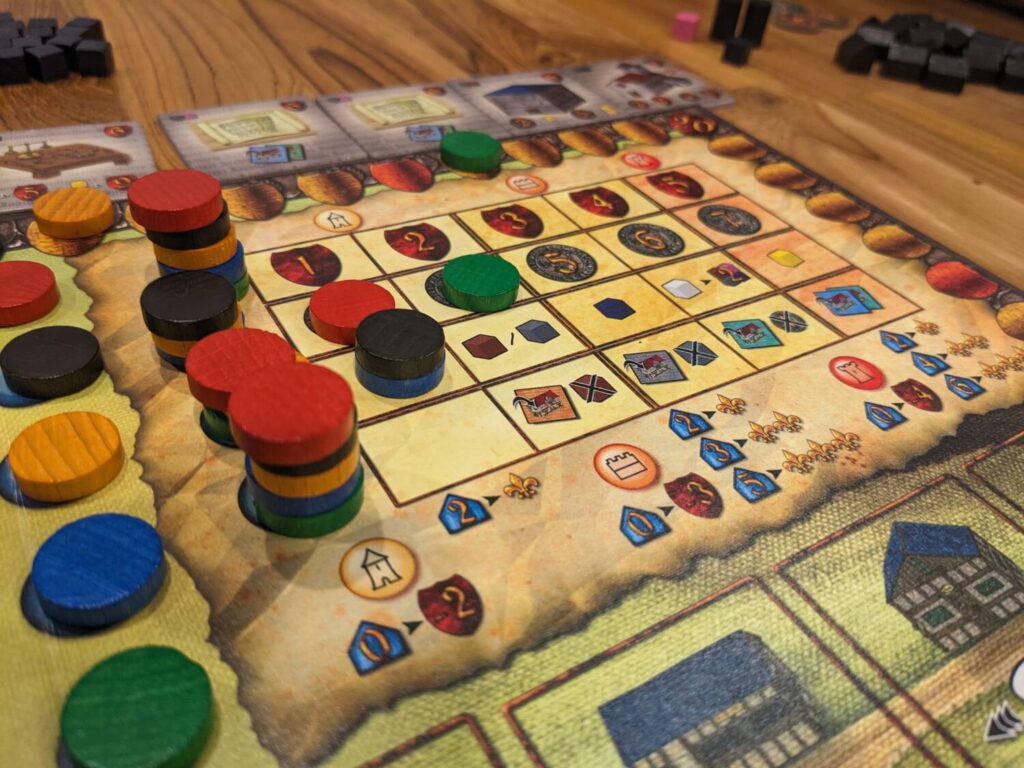The guys in my Wednesday gaming group started a push last year to play more of the old, dust-ridden games at the bottom and backs of our respective game closet shelves. The premise was simple: let’s try to remember why we keep all these old games when all we ever play now are the newest, shiniest things in shrink.
Right on the spot, the Dusty Euro Series was born. In order to share some of these experiences with you, I’ll be writing a piece from time to time about a game that is at least 10 years old that we haven’t already reviewed here at Meeple Mountain. In that way, these articles are not reviews. These pieces will not include a detailed rules explanation or a broad introduction to each game. All you get is what you need: my brief thoughts on what I think about each game right now, based on one or two fresh plays.

Caylus: What Is It?
Caylus is a 2-5 player worker placement game first released in 2005 and published by Ystari Games. It was available through the App Store until a couple years ago and that was my first exposure to the game. It is now available for free on Board Game Arena. One of the guys in my Wednesday group, Dan, broke it out twice over the last couple months so I had the chance to dig back into Caylus, but those two plays were my first “in real life” games of Caylus.
The setting of Caylus is typically abstract for games of this time period. It’s the late 1200s, and players take on the role of “master builders” to earn the King’s favor by building a castle worthy of the King’s name. Or something. Over the course of a series of turns across three main stages (representing the three portions of the castle), players try to earn points by earning Royal Favors and constructing buildings that can later be used by all players.
Here’s what Caylus is now: a tight, somewhat stabby experience that still works exceptionally well…as long as players lean into the “stabby.”

Turns are broken into seven phases, but the reality is that two of those phases comprise 98% of the game.
Phase two is known as “placing workers.” Each player has access to a small pool of six workers, but it costs at least a buck (“deniers”, in the game’s language) to place a worker each turn. It’s standard fare—place a guy on the building that gets one wood or one food, and you’ll get the building’s resources later, during the other major phase that takes up a good portion of the game, “activation of the buildings.” (Things were so simple in the old days.)
What makes phase two so cool is that the price of placing a worker can escalate quickly. That’s because when someone decides to pass, each player’s next worker placement costs two deniers. If a second player passes, that means it costs three deniers for each worker placed.
In a game where money is tight, I find that the wave of players passing really changes the game of Caylus quickly. This is a good thing. The tension starts as soon as each player gets their beginning-of-the-round income of two deniers. If a player ended the previous round with zero cash, that means they can place a maximum of just two workers. Knowing that this player is probably going to pass on their third action is huge. It’s even more interesting when that player is first in turn order, hosing everyone by allowing for only two cheap actions before costs rise exponentially.
So, there’s that. Also, this is a worker placement game where you place workers then wait to allow those workers to activate. The Caylus board is designed to let the buildings activate in the same order every round, starting from the top of a long, winding road with special buildings that grant powers like discounted worker actions, a three-denier bonus, flipping the turn order, etc. before giving players access to the buildings that generate resources.

That also means that if you planned to take an action that required two wood, you need those wood when that action comes around. Gosh, watching players not plan for this correctly is some of the cringiest stuff in gaming. (Yes, “cringiest” is a word.) You’ve really got to be careful in Caylus because you want to do a lot of things each turn but need the resources in-hand before you can do much of anything!
Even gaming veterans blow it from time to time, myself included. That’s because you may start a turn by placing a worker early in the building activation order, hoping that no one else snakes a building you need later to generate enough stuff to build another building later in the round…the timing considerations are maybe the best part of Caylus.
There’s another thing I haven’t mentioned: phase 4, “the provost’s move.” During phases three and four, players can move a pawn forwards or backwards that dictates the end of where buildings will activate. Moving this pawn, the provost, can prove spicy. During phase three, one player can move the provost forwards or backwards up to three spaces for free. During phase four, players move the provost in passing order—not turn order—as many spaces as they want, paying one denier per space. (Remember, money is really tight in this game.)
This also gives a lot of weight to the decision on when to pass. Moving the provost last is pretty big.
Do I want to pay a denier to move the provost backwards a space to hose my “friend” Andy, to ensure that his worker on the two-wood building doesn’t activate? I might. Do I want to pay two deniers to move the provost ahead, to ensure that no one else can hose me when their chance at moving the provost backwards comes up? Oh, I just might.
As a worker placement game where players get stuff to build other stuff goes, Caylus can be pretty dry straight-up. But the provost moves, the timing considerations on when you get things to build other things, the Royal Favors (which include cash, building bonuses, resources and/or straight-up victory points) that come as a result of building out the castle or when placing certain buildings…all of this makes the game a lot juicier. Players also get a point any time a different player puts a worker on their building (whether it activates later or not), so selecting the right buildings to place on the map becomes another fun consideration because of the points drip.

I Love It, But—
Caylus is a great time, and it’s one of those olden-time Euros that works almost 20 years later. I still prefer the full player count of five, and it works best if players are willing to play a little dirty as they race to complete goals and squeeze players out of some worker actions.
But as I found in a recent five-player game of Caylus (with three new-to-Caylus players), playing this as a standard Euro makes the game pretty average and a bit dry. (Dusty, even.) We had a situation where for three consecutive rounds, the player(s) who chose to activate the “build new buildings” locations didn’t have the proper resources to build. The game ground almost to a halt, with players suddenly having a ton of cash—which never really happens in a game this tight on cash!—and not enough buildings to activate.
This, plus players choosing to not hose others by moving the provost backwards, killing off some of the potential rewards in a round, made Caylus feel…normal. Not very interesting. Low scoring. And if all players have an equal number of desirable buildings, everyone scores a point or two every round, keeping scores even.
In that game, we didn’t build any of the residential buildings, which meant we also didn’t build any of the prestige buildings, which grant massive victory point bonuses when constructed (some as much as 16 points!).

The WINNER of this game scored 48 points, easily the lowest score I’ve ever seen in a game where the score track reaches 100. And while the worker placement mechanics of Caylus are always interesting, they are far from unique without the mix of other things that should be going on in a more cutthroat version of the game.
That left me firmly set on pushing a few things for future games. I should really push players to move the provost around; if players don’t use the provost, Caylus just isn’t Caylus. Push players to either build lots of buildings or build parts of the castle to earn Royal Favors, but to really focus on the resource collection timing considerations. Remind players about the importance of building the Lawyer, the building that allows others to build residential buildings, so that later someone will build the Architect, used to build prestige buildings.
Despite this most recent play, I think Caylus holds up exceptionally well for its age and it’s a game I will always play. While I wish there was an app to play on my iPad, I’m glad that it’s available on BGA for others to enjoy with friends and that this one is not gated by premium access since it is so old. I’m even more intrigued about playing Caylus 1303 now, especially given Tom’s four-star review of the newer version.
Give this a look, or even better, whip out your own dusty copy from the back shelf!!












I don’t have this one, and I have not played it. The $148.08 price tag (above) kinda scares me…